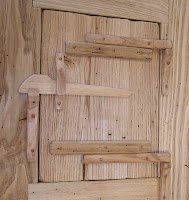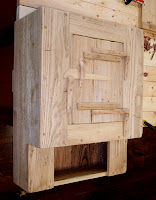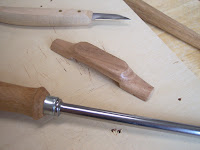 I don't think I've ever been more disappointed to see a project come to its final stages. I have only to add a few more dowels and apply finish and this project is done. The amount of
I don't think I've ever been more disappointed to see a project come to its final stages. I have only to add a few more dowels and apply finish and this project is done. The amount of  handwork involved provided so many quiet hours of meditation-like focus that I forgot all about the things I "should" be doing. (Which isn't necessarily a good thing!)
handwork involved provided so many quiet hours of meditation-like focus that I forgot all about the things I "should" be doing. (Which isn't necessarily a good thing!)
After final shaping, I used a burnisher on the edges of the handle to shine it up a bit. The original handle is
 shiny and smooth from years of oily hands opening the cupboard.
shiny and smooth from years of oily hands opening the cupboard.I tested a few finishes on scrap pieces—Boiled Linseed Oil, Tung Oil, and Watco Wipe-On Poly—and found that BLO darkened the wood the right amount. A couple coats of that, a week or so to cure, and then a topcoat of dark paste wax ought to age the cupboard enough that it will look a little more like the original.






20 comments:
Your cupboard looks great! I love the wooden hinges.
Thanks Ron! Would you believe I just dropped the door and broke one of the hinges? Yep, I did.
Wow VC, that looks awesome! Great job!
I really like the used and distressed look and feel. If one used this technique with much of our functional furniture we would not be in such bondage to worrying about it getting damaged. Furniture that one really use and live with.
You are so right, Jeff. In fact, when I dropped the door and broke a hinge, all I did was glue it back together (with glue line showing) and it looks as good as "old".
Thanks Shazza!
Wow, its beautiful! I understand the sadness at the projects ending. I love something that steals my thoughts and consentration so fully.
I would add that it takes skill to do this distressing properly. Too much is, well...too much. It also cannot simply be random. Thought must go into what will be worn and where. So while it isn't random, it is also not uniform.
What type of tinted wax will you use?
Be sure to post pictures of the finished product.
Jeff, I use Staples Dark Brown Paste Wax. I have no idea where I got it but I've used it for years. It has carnauba wax in it.
You're right about the distressing. It's easy to go overboard.
I'll definitely post pictures when it's done. It will be another week and a half most likely.
Someday you will have explain the need for the wax, I have never used wax on any of my projects and know feel I screwed somehting up.
Wyld, you haven't screwed anything up. There are a million ways to finish furniture. I'm only using wax because I like the soft sheen it produces and in this case, because I'm using a dark brown wax, the way it will affect the color.
Wax has some protective qualities and it helps keep dust off your furniture. It also helps a little with scratch resistance. If anyone else has other reasons for using wax, feel free to chime in.
Love the cabinet Hope ya used Hide glue to repair that hinge, seems out of character to use anything else.
Ace, you mean they didn't use titebond III back in the 18th c.?
Uh oh...
I'll tell ya this, once I discovered Hide glue and learned how to use it I'll never go back to Titebond.
Spent the day gluing up a project and came into the house and cleaned up with soap and water. 8>)
I used hide glue once. It set up too fast for me and by the time I was through with glue-up, I was a sweaty, jittery, foul-word spewing mess.
Moreover, hide glue smells like a mixture of kitty litter and stinky socks. :o(
...not that I would know what stinky socks smell like, of course.
I have converted to hide glue for anything that allows me the open-time to use it. I still don't have the courage to use it on a panel glue-up, especially the method of friction gluing whereby no clamps are used and the panel is just leaned against the wall. However, I have used the friction method on smaller pieces and it works!
Regarding wax, I have found it difficult to replicate the soft buttery feel of a piece finished with linseed oil (many coats), and wax. You can really feel the texture and warmth of the wood itself. The wax adds the glow that is missing with oil alone, and also adds some surface protection, as you noted. The closest I have come to this without using wax is with Minwax Antique Oil or Sam Maloof's oil-varnish formula, but even with those, there is a plastic feel to the final product. Of course, they provide protection that the oil and wax combo do not.
The other thing with hide glue that's a plus, is after it dries, any squeeze out is easy to snap off with a chisel. It definitely has one up on titebond with that.
I've heard good things about Minwax antique oil and thought about trying it. You are right that the varnish adds more protection. I figured a cupboard won't get abused too much, so the BLO and wax should be enough.
Of course, the cupboard IS going to hang in my shop...
What is nice about the Minwax Antique Oil is that you have complete control over the final surface. You simply brush it on, and as soon as it starts to get thick and tacky, wipe/rub it off. It leaves behind an ever-so thin film that has a satin sheen. You won't notice much on the first coat, but you can slowly build it up to whatever thickness you desire. No worry about drips, dust, etc.
Cool, thanks for the recommendation!
Post a Comment